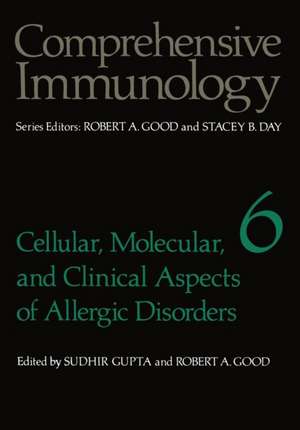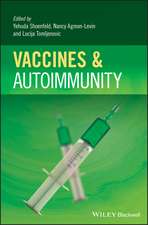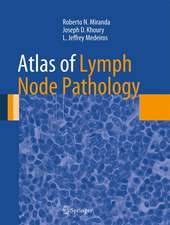Cellular, Molecular, and Clinical Aspects of Allergic Disorders: Comprehensive Immunology, cartea 6
Editat de Sudhir Guptaen Limba Engleză Paperback – 27 dec 2012
Preț: 743.69 lei
Preț vechi: 782.84 lei
-5% Nou
Puncte Express: 1116
Preț estimativ în valută:
142.30€ • 148.58$ • 117.78£
142.30€ • 148.58$ • 117.78£
Carte tipărită la comandă
Livrare economică 04-18 aprilie
Preluare comenzi: 021 569.72.76
Specificații
ISBN-13: 9781468409901
ISBN-10: 1468409905
Pagini: 652
Ilustrații: XIX, 628 p.
Dimensiuni: 178 x 254 x 34 mm
Greutate: 1.11 kg
Ediția:Softcover reprint of the original 1st ed. 1979
Editura: Springer Us
Colecția Springer
Seria Comprehensive Immunology
Locul publicării:New York, NY, United States
ISBN-10: 1468409905
Pagini: 652
Ilustrații: XIX, 628 p.
Dimensiuni: 178 x 254 x 34 mm
Greutate: 1.11 kg
Ediția:Softcover reprint of the original 1st ed. 1979
Editura: Springer Us
Colecția Springer
Seria Comprehensive Immunology
Locul publicării:New York, NY, United States
Public țintă
ResearchCuprins
1 Basophils and Mast Cells: Structure, Function, and Role in Hypersensitivity.- 1. Introduction.- 2. Origin, Distribution, and Morphology.- 2.1. Origin and Normal Distribution.- 2.2. Morphology.- 2.3. Phylogenetic Considerations.- 3. Chemical Mediators of Hypersensitivity Reactions.- 3.1. Histamine and Histamine-Synthesizing Capacity.- 3.2. Proteoglycans.- 4. Role in Immediate Hypersensitivity Reactions.- 4.1. Introduction.- 4.2. Homocytotropic Antibody.- 4.3. Mechanisms of IgE-Mediated Histamine Release.- 4.4. Other Factors That Induce Degranulation.- 5. Morphological Features of Basophil Degranulation.- 5.1. Basophil Anaphylactic Degranulation.- 5.2. Degranulation of Basophils Participating in Delayed-Onset Hypersensitivity Reactions.- 5.3. Model of Basophil Degranulation.- 5.4. Mast Cell Degranulation.- 6. Roles in Hypersensitivity Reactions of Delayed Onset.- 6.1. Introduction.- 6.2. Homocytotropic Antibody-Mediated Reactions with Delayed Components.- 6.3. Basophils in Delayed-Onset Immunological Reactions.- 6.4. Mast Cells in Delayed-Onset Immunological Reactions.- 6.5. Role of Basophils and Mast Cells in Delayed-Onset Immunological Reactions.- 7. Summary.- 8. References.- 2 Participation of Eosinophils in Immunological Systems.- 1. Introduction.- 2. Description of the Eosinophilic Leukocyte.- 2.1. History.- 2.2. Structure.- 2.3. Enzyme Content.- 2.4. Surface Receptors.- 3. Eosinophilopoiesis.- 3.1. Normal Production and Distribution of Eosinophils.- 3.2. T-Lymphocyte Involvement in Accelerated Eosinophilopoiesis and Eosinophilia.- 4. Regulation of Eosinophil Migration and Localization.- 4.1. Complement-Generated Factors.- 4.2. Mast-Cell-Derived Factors.- 4.3. Neutrophil-Derived Factors.- 4.4. Lymphocyte-Derived Factors.- 4.5. Other Chemotactic Substances.- 5. Functional Roles of Eosinophils and Clinical Relationships.- 5.1. Atopic Allergies.- 5.2. Immune-Complex-Mediated Disorders.- 5.3. Syndromes of Varied or Unknown Etiologies.- 5.4. Neoplasias.- 5.5. Infectious Diseases.- 6. Concluding Statement.- 7. References.- 3 Lymphocyte Subpopulations and Functions in Hypersensitivity Disorders.- 1. Introduction.- 2. Development of Thymus and T Lymphocytes.- 3. Development of B Lymphocytes.- 4. Lymphocyte Markers.- 4.1. Surface Immunoglobulin.- 4.2. Receptors for IgG Fc.- 4.3. Complement Receptors.- 4.4. Receptors for Mouse Erythrocytes.- 4.5. Epstein-Barr Virus (EBV) Receptor.- 4.6. Receptors for Spontaneous Rosette Formation with Macaca Monkey RBC.- 4.7. Human “Ia-like” Alloantigens.- 4.8. Human Thymic Lymphocyte Antigens (HTLA).- 4.9. Receptor for Sheep Erythrocytes.- 4.10. Receptors for Rhesus Monkey Erythrocytes.- 4.11. Receptors for Helix promatia Hemagglutinin.- 4.12. Receptors for Spontaneous Autorosette Formation.- 4.13. ?-Naphthyl-acetate Esterase.- 4.14. Distribution of Lymphocyte Subpopulations in Peripheral Blood, Tissues, and Extravascular Fluids.- 5. Functional Properties of Human T, B, and Third-Population Cells.- 6. Proliferative Responses to Mitogens, Antigens, and Allogeneic Cells.- 7. Lymphocyte Mitogenic Factor (LMF).- 8. Migration Inhibition Factor (MIF).- 9. Interferon Production.- 10. Chemotactic Factors.- 11. Cell-Mediated Lympholysis (CML).- 12. Antibody-Dependent and Spontaneous Cell-Mediated Cytotoxicity.- 13. Precursor Cells among the So-Called Third Population of Lymphocytes.- 14. Human T-Cell Subpopulations.- 14.1. Specificity of Immunoglobulin Receptors on T-Cell Subpopulations.- 14.2. Histamine Receptors.- 14.3. Morphology of T? and T? Cells.- 14.4. Sensitivity of T-Cell Subpopulations.- 14.5. RNAContent of T? and T? Cells.- 14.6. Compartmental Distribution of T-Cell Subsets.- 14.7. Response of T-Cell Subpopulations to Mitogens and Allogeneic Cells.- 14.8. Leukocyte Migration Inhibition Factor Production.- 14.9. Locomotor Properties of T-Cell Subpopulations.- 14.10. Suppressor and Helper Functions of T-Cell Subsets.- 14.11. Antibody-Dependent (ADCC), Spontaneous (SLMC), and Mitogen-Induced (MICC) Cytotoxicity.- 15. Atopic Dermatitis.- 16. Cellular Immunity.- 16.1. T Lymphocytes.- 16.2. Lymphocyte Transformation.- 16.3. Delayed-Type Hypersensitivity.- 16.4. Humoral Immunity.- 16.5. B Lymphocytes.- 16.6. Serum Immunoglobulins.- 17. Bronchial Asthma and Allergic Rhinitis.- 17.1. Cell-Mediated Immunity: T Lymphocytes.- 17.2. Lymphocyte Transformation and Mediator Production in Response to Mitogens and Antigens.- 17.3. Humoral Immunity: B Lymphocytes.- 17.4. Serum Immunoglobulins.- 17.5. Antibody-Dependent Cell-Mediated Cytotoxicity (ADCC).- 17.6. Cyclic Nucleotides in Leukocytes of Atopic Subjects.- 17.7. Polymorphonuclear Leukocyte and Monocyte Chemotaxis in Atopic Disease.- 18. Drug Hypersensitivity.- 19. Summary.- 20. References.- 4 Molecular Properties of Allergens.- 1. Allergens or Antigens.- 2. Types of Antigenic Determinants.- 3. B-Cell-Specific Antigenic Determinants.- 3.1. Experimental Approaches.- 3.2. Antigenic Determinants Reacting with IgG Antibodies: Size, Structure, and Conformation.- 3.3. Antigenic Determinants Reacting with IgM Antibodies.- 3.4. Antigenic Determinants Reacting with IgE Antibodies.- 4. T-Cell-Specific Antigenic Determinants.- 4.1. Experimental Approaches.- 4.2. Size, Structure, and Conformation.- 5. Concluding Remarks.- 6. References.- 5 Immunoglobulin E: Biosynthesis and Immunological Mechanisms of IgE-Mediated Hypersensitivity.-1. Introduction.- 2. Mechanisms of IgE-Mediated Hypersensitivity.- 2.1. Immunological Properties of IgE Antibody.- 2.2. Mechanisms of Sensitization.- 2.3. Immunological Mechanisms of IgE-Mediated Reactions.- 3. IgE Antibody Response and Regulation.- 3.1. Precursor B Lymphocytes of IgE-Forming Cells.- 3.2. Requirement of T-Helper Cells in IgE Response.- 3.3. Regulation of IgE Antibody Response by Suppressor T Cells.- 3.4. Experimental Model of Immunotherapy.- 4. References.- 6 Mediators of Immediate Hypersensitivity.- 1. Introduction.- 2. Physicochemical Characteristics, Metabolism, and Pharmacological Actions of Mediators.- 2.1. Preformed Mediators.- 2.2. Newly Generated Mediators.- 3. Mast Cell Degranulation: Biochemical Mechanisms and Controls.- 3.1. Agents Which Initiate Mast Cell Degranulation.- 3.2. Biochemical and Morphological Aspects of Degranulation.- 3.3. Modulating Agents.- 3.4. A Conceptual Model for Cell Activation.- 4. Interaction of the Mediators of Immediate Hypersensitivity with Humoral and Cellular Elements of the Immune System.- 4.1. Interaction with Humoral Elements.- 4.2. Interaction with Cellular Elements.- 4.3. Regulation of the Immediate Hypersensitivity Response in Tissue.- 5. References.- 7 The Genetics of Allergy.- 1. Introduction.- 2. Immunogenetics.- 2.1. Transplantation Biology.- 2.2. Cell Cooperation and Genetic Restriction.- 2.3. Antibody Diversity.- 2.4. Polymorphisms to Complex Antigens.- 3. Cognitive Function.- 3.1. Nutrient Recognition.- 3.2. Pollen Biology.- 3.3. The Immune System.- 3.4. The Central Nervous System.- 4. Problem Solving in Clinical Immunogenetics.- 4.1. Multifactorial Diseases.- 4.2. Clinical Phenotypes.- 4.3. Environmental Interactions.- 4.4. Antigens.- 4.5. Sampling Problems.- 4.6. Models and Solutions.- 4.7. Multivariate Analysis.- 5. HLA-Associated Diseases.- 5.1. Disease Associations.- 5.2. Hypothetical Mechanisms.- 5.3. Predictions and Prevention.- 6. Human Immune Response Genes.- 6.1. Allergic Diseases.- 6.2. Immunoglobulin E.- 6.3. Allergen Response Polymorphisms.- 6.4. Infectious Diseases.- 7. References.- 8 Urticaria and Angioedema.- 1. Introduction.- 2. Mediator Pathways of Urticaria and Angioedema.- 3. Causes of Urticaria and Angioedema.- 4. Physical Urticarias and Angioedema.- 4.1. Cold Urticaria.- 4.2. Cholinergic Urticaria.- 4.3. Dermographism.- 4.4. Pressure Urticaria (Angioedema).- 4.5. Solar Urticaria.- 4.6. Aquagenic Urticaria.- 5. Hereditary Forms of Urticaria and Angioedema.- 5.1. Familial Cold Urticaria.- 5.2. Hereditary Vibratory Angioedema.- 5.3. C3b Inactivator Deficiency.- 5.4. Urticaria and Amyloidosis.- 5.5. Hereditary Angioedema.- 6. Vasculitis and Urticaria.- 7. Chronic Idiopathic Urticaria and Idiopathic Angioedema.- 8. References.- 9 Food Hypersensitivity.- 1. Introduction.- 2. Plan of Presentation.- 3. Basic Immunology.- 3.1. Local Components.- 3.2. Systemic Components.- 3.3. Developmental Features.- 3.4. Genetic Factors.- 3.5. Components of Immunological Reactions.- 3.6. Types of Immunological Reactions.- 4. Clinical Immunology.- 4.1. The Mucosal Barrier and the Immune System.- 4.2. Detection of Reaginic Sensitization.- 4.3. Detection of Nonreaginic Sensitization.- 5. Clinical Manifestations.- 5.1. Adverse Reactions to Foods.- 5.2. Unproven “Syndromes”.- 5.3. Immunological Reactions to Foods.- 5.4. Reagin-Mediated Reactions.- 5.5. Reactions Not Reagin Mediated.- 6. Clinical Applications.- 6.1. History and Physical Examination.- 6.2. Confirmation of Reported Adverse Reaction to Food.- 6.3. Differential Diagnosis.- 6.4. Evidence of SpecificImmunological Sensitization.- 6.5. Reactions Reagin Mediated.- 6.6. Reactions Not Reagin Mediated.- 6.7. Management.- 7. Envoi.- 8. References.- 10 Drug Allergy.- 1. Introduction.- 2. Clinical Manifestations of Drug Allergy.- 2.1. Anaphylactic Shock.- 2.2. Serum Sickness Syndrome.- 2.3. Cutaneous Manifestations.- 2.4. Hematological Manifestations.- 2.5. Vasculitis and Connective Tissue Damage.- 2.6. Hepatic Damage.- 2.7. Fever.- 2.8. Nephropathy.- 2.9. Pulmonary Manifestations.- 2.10. Miscellaneous.- 3. Immunochemistry and Immunopathology of Drug Reactions.- 3.1. Chemical Properties Involved in the Allergenic Potential of Drugs.- 3.2. Induction of Immune Responses to Drugs: Main Factors Involved.- 4. Principal Allergenic Drugs.- 4.1. Penicillins and Cephalosporins.- 4.2. Other Antibiotics.- 4.3. Sulfonamides.- 4.4. Aspirin.- 4.5. Antipyretic and Analgesic Drugs.- 5. Diagnosis of Drug Allergy.- 5.1. Case History.- 5.2. Skin Tests.- 5.3. In Vitro Tests.- 5.4. Provocation Tests.- 6. Therapy.- 6.1. Prophylaxis.- 6.2. Hyposensitization.- 7. References.- 11 Insect Allergy: Stinging and Biting Insects.- 1. Introduction.- 2. Stinging Insects: “Winged” Hymenoptera.- 2.1. Clinical Aspects.- 2.2. Immunopathogenesis.- 2.3. Diagnosis.- 2.4. Therapy.- 3. Fire Ant.- 4. Biting Insects.- 5. References.- 12 Nasal Hypersensitivity.- 1. Introduction.- 2. Common Syndromes of Nasal Disease.- 2.1. Seasonal Allergic Rhinitis.- 2.2. Perennial Allergic Rhinitis.- 2.3. Nonatopic or Infectious Rhinitis.- 2.4. Vasomotor Rhinitis.- 2.5. Rhinitis Medicamentosa.- 2.6. Anatomical Lesions as a Cause of Rhinitis.- 2.7. Neurogenic Rhinitis.- 2.8. Food Intolerance as a Cause of Rhinitis.- 2.9. Hormonal Rhinitis.- 2.10. Atrophic Rhinitis.- 2.11. Chemical Rhinitis.- 2.12. Rhinitis Associated with NasalPolyps.- 2.13. Psychosomatic Rhinitis.- 3. Incidence of the Syndromes of Nasal Disease.- 4. Histological Classification of Nasal Disease.- 4.1. Normal Histology of the Nasal Membrane.- 4.2. Abnormal Histological Features Suggesting Nonimmunological Causes of Nasal Disease.- 4.3. Abnormal Infiltrates Suggesting Nonimmunological Causes of Nasal Disease.- 4.4. Abnormal Infiltrates Suggesting Immunological Causes of Nasal Disease.- 5. Summary.- 6. References.- 13 Pathogenesis of Bronchial Asthma.- 1. Introduction.- 2. Clinical Classification and Pathology.- 2.1. Classification.- 2.2. Pathology.- 3. Normal Anatomy and Innervation.- 3.1. Cells of the Pulmonary Airways.- 3.2. Nerve Supply of the Lung.- 3.3. Control Mechanisms.- 3.4. Bronchial Airways.- 4. Allergic Asthma (Extrinsic).- 4.1. Immunological Basis.- 4.2. Allergens.- 4.3. Chemical Mediators.- 4.4. Cholinergic Reflex Pathways.- 5. Idiopathic Asthma (Intrinsic).- 5.1. Hyperresponsive Cholinergic Receptors.- 5.2. Partial ?-Adrenergic Blockade.- 5.3. Hyperresponsive a-Adrenergic Receptors.- 5.4. Alternative Hypotheses.- 5.5. Aspirin Sensitivity.- 5.6. Exercise-Induced Asthma.- 5.7. Viral Infections Inducing Asthma.- 5.8. Emotions and Bronchial Asthma.- 6. References.- 14 Immunological Features of Infiltrative Pulmonary Disease.- 1. Introduction.- 2. Hypersensitivity Pneumonitis (Extrinsic Allergic Alveolitis).- 2.1. Etiology.- 2.2. Clinical Features: Disease Presentation.- 2.3. Diagnosis.- 2.4. Therapy.- 2.5. Pathogenesis.- 3. The Eosinophilic Pneumonias.- 3.1. Eosinophilic Pneumonias with Asthma.- 3.2. Eosinophilic Pneumonias without Asthma.- 4. Pulmonary Fibrosis.- 4.1. Connective Tissue Diseases.- 4.2. Occupational Diseases.- 4.3. Infectious and Idiopathic Diseases.- 5. References.- 15 Augmented Immunglobulin ESynthesis in Primary Immunodeficiency.- 1. Introduction.- 2. Potential Mechanisms for Augmented IgE Synthesis in Immunodeficiency.- 3. Excessive IgE Synthesis in Primary Immunodeficiency Disorders.- 3.1. The Wiskott-Aldrich Syndrome.- 3.2. DiGeorge’s Syndrome.- 3.3. Nezelof’s Syndrome.- 3.4. Selective IgA Deficiency.- 3.5. The Hyper-IgE Syndrome.- 4. References.- 16 Hypersensitivity Vasculitis: The Acute Phase of Leukocytoclastic (Necrotizing) Lesions.- 1. Properties of Complexes and Immune-Complex-Mediated Responses.- 1.1. Introduction: Arthus-Like Responses and Vasculitis.- 1.2. Properties of Immune Complexes in Relation to Tissue Damage.- 1.3. Increased Vascular Permeability and Deposition of Complexes.- 1.4. Sequence of Changes in Arthus-Type Reactions.- 2. Investigations of Human Vasculitis.- 2.1. Detection of Immunoglobulins and Complement C3 in Various Forms of Vasculitis.- 2.2. Comments on the Significance of Immunoglobulins in Lesions.- 2.3. Partial “Immune Deficiency” and Weak-Affinity Antibodies in Immune Complex Disorders.- 2.4. Histamine-Mediated Vasculitis.- 3. Identification of Antigens Possibly Forming Immune Complexes in Patients with Cutaneous Vasculitis.- 3.1. Bacterial Antigen in Immune Complexes and Vasculitis Lesions.- 3.2. Virus as Antigen in Immune Complexes.- 3.3. DNA as Antigen in Immune Complexes.- 3.4. Cryoglobulins as Immune Complexes in Vasculitis.- 4. Possible Contribution of Rheumatoid Factors to Vasculitis.- 4.1. Serum Rheumatoid Factors.- 4.2. Tissue-Bound, Possibly Locally Formed, Rheumatoid Factors.- 5. Role of C-Reactive Protein in Vasculitis.- 6. Summary of Investigations on Human Vasculitis.- 7. References.- 17 Laboratory Diagnosis of Immediate Hypersensitivity Disorders.- 1. Introduction.- 1.1. Clinical Indication.- 1.2.Standardization of Major Allergens.- 2. Skin Testing.- 2.1. Introduction.- 2.2. Test Procedures.- 2.3. Clinical Interpretation.- 3. Determination of Total and Specific IgE.- 3.1. Introduction.- 3.2. Measurement of Total IgE.- 3.3. Measurement of Specific IgE.- 4. Measurement of Specific IgG.- 4.1. Double Antibody Technique.- 4.2. Clinical Significance.- 5. Auxiliary Procedures.- 5.1. Histamine Release from Leukocytes in Vitro.- 5.2. Passive Sensitization.- 5.3. Bronchial and Conjunctival Challenge.- 6. Summary.- 7. References.- 18 Immunological and Pharmacological Management of Allergic Diseases.- 1. Allergic Rhinitis.- 1.1. Immunological Management.- 1.2. Pharmacological Management.- 2. Asthma.- 2.1. Definition.- 2.2. IgE-Triggered Asthma.- 3. Anaphylaxis.- 3.1. Immunological Management.- 3.2. Pharmacological Management.- 4. Urticaria and Angioedema.- 4.1. Immunological Management.- 4.2. Pharmacological Management.- 5. Allergic Bronchopulmonary Aspergillosis (ABPA).- 5.1. Diagnosis.- 5.2. Management.- 6. Hypersensitivity Pneumonitis.- 6.1. Recognition.- 6.2. Management.- 7. References.




















